June 11, 2015
There’s a lot of talk these days about greenhouse gases and how they’re heating up our planet, slowly but surely. But what are they? For those of us who snoozed through high school chemistry class dreaming of our favorite Ben & Jerry’s flavor, here’s a refresher.
A greenhouse gas is any gaseous compound that absorbs infrared radiation—that’s sunlight! These gaseous compounds (some natural and some man-made) absorb the sun’s rays and trap that heat in the earth’s atmosphere. For millions of years, the proper balance of gases in the atmosphere, ebbing and flowing, has led to a livable planet that’s not too hot and not too cold in most places. Since the Industrial Revolution, we have been wreaking havoc on that balance. Releasing a variety of gases, we’ve drastically increased the atmosphere’s ability to hold heat.
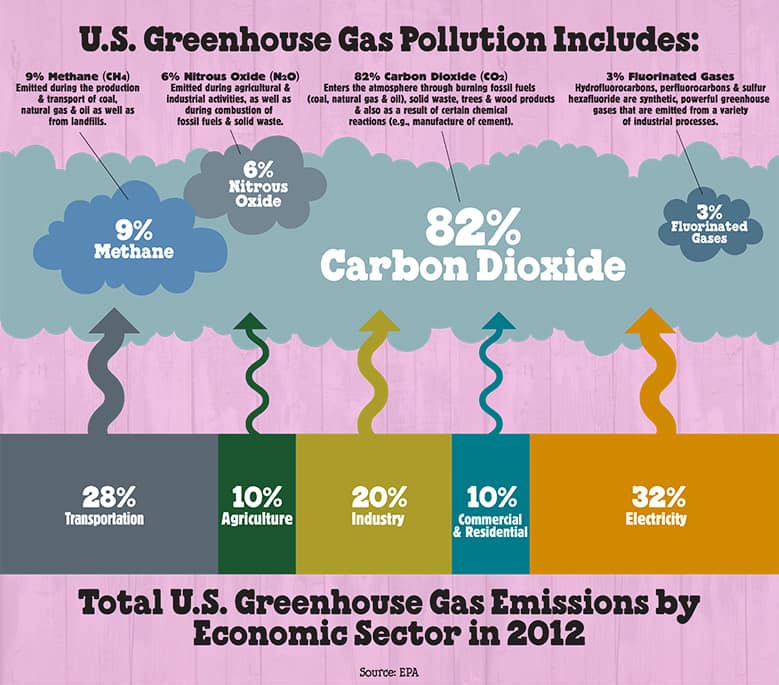
TAKE ACTION NOW: Sign the petition for clean energy!
Here’s a closer look at the major contributors to global climate change:
Carbon Dioxide (CO2)
Everybody knows carbon dioxide (CO2) is the destructive, billowing gas that’s warming our planet. It’s public enemy number one, and the greatest cause of man-made 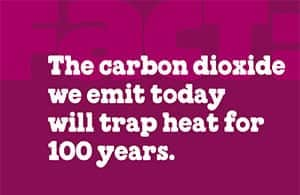 global warming by virtue of the sheer volume we’re emitting. CO2 is perfectly fine in lower concentrations. It allows plants to grow, and helps keep our planet habitable by the trapping of some of the sun’s warmth. But by brazenly burning coal, oil and natural gas for heat, electricity, industry and transportation, we are altering our climate much faster than at any other point in millions of years. Forests and oceans that used to absorb most of that CO2 are reaching their saturation point.
global warming by virtue of the sheer volume we’re emitting. CO2 is perfectly fine in lower concentrations. It allows plants to grow, and helps keep our planet habitable by the trapping of some of the sun’s warmth. But by brazenly burning coal, oil and natural gas for heat, electricity, industry and transportation, we are altering our climate much faster than at any other point in millions of years. Forests and oceans that used to absorb most of that CO2 are reaching their saturation point.
Since the Industrial Revolution, we’ve increased the concentration of CO2 in the atmosphere by a whopping 40%, from a volume of 280 to more than 380 parts per million.
Addressing CO2 emissions is unquestionably the biggest task for our leaders, and for each of us as individuals. We need a global movement towards carbon-free energy sources, efficiency programs, conservation and reforestation (carbon sinks). This is the herculean task of our time.
Methane (CH4)
Methane is responsible for about 20% of man-made climate change to date, but it’s 25 times more potent than carbon dioxide as a greenhouse gas and if we don’t change our ways, 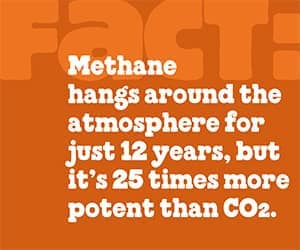 it has the potential to cause catastrophic warming.
it has the potential to cause catastrophic warming.
This colorless, odorless gas is all around us, seeping up from wetlands and marshes, the oceans and the bellies of livestock. It is also, however, the primary component of natural gas. As energy demands increase, this powerful greenhouse gas is being emitted rapidly. Scientists also worry that warming may trigger the release of methane deposits trapped in the arctic permafrost and in the ocean floor. If that happens, we could see runaway climate change.
As you may notice, our actions are interdependent. We need to address all of these causes of climate change or all of these gases will work against us.
Methane is a target for immediate action because of its potency. Trapping and burning off the methane released from landfills helps. Burning or capturing the methane released during the extraction of natural gas is a step in the right direction, but we also need to leave a lot of that natural gas in the ground.
Nitrous Oxide (N2O)
Scientists say nitrous oxide is the third most damaging man-made natural gas, accounting for 7% of the warming we’ve seen thus far. This one is 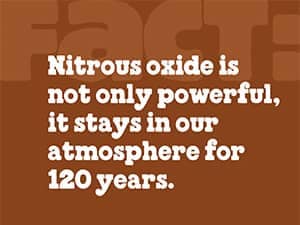 actually 298 times stronger than carbon dioxide when it comes to trapping heat.
actually 298 times stronger than carbon dioxide when it comes to trapping heat.
Like most greenhouse gases, nitrous oxides are a totally normal component of our planet. Nitrous oxide is created when bacteria digests plant matter. Nitrous oxides are part of the nitrogen cycle, which is vital to our planet’s ability to support plant life, build soil and cycle nutrients.
Human responsibility for the uptick in nitrous oxide emissions is a textbook example of too much a good thing. We realized by pumping more nitrogen into the soil we could increase yields. Human agricultural systems have been loading up on artificial nitrogen fertilizers to compensate for our degradation of soils, and spiking levels of nitrous oxide in the process.
Humans are pouring more than 70 million tons of chemical fertilizer on the land annually, drastically increasing nitrogen inputs and once again throwing a completely natural system way out of whack.
While we’ve largely eliminated nitrous oxide from human industrial and transportation emissions, we now need to turn our focus to how, where and when we apply nitrogen fertilizers to our land. As the human population grows and demand for food increases, this will be an important challenge.
The Industrial Gases: Fluorinated Gases or Halocarbons
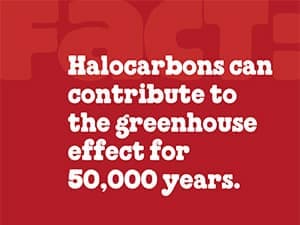 There are a number of other greenhouse gases created by humans that are not naturally occurring in the atmosphere. We’ve already shown the ability to tackle these through global treaty, like the Montreal Protocol in 1987, when we progressively banned CFCs (chloroflurocarbons).
There are a number of other greenhouse gases created by humans that are not naturally occurring in the atmosphere. We’ve already shown the ability to tackle these through global treaty, like the Montreal Protocol in 1987, when we progressively banned CFCs (chloroflurocarbons).
Now, we need to set our sights on some of the other fluorinated gases or halocarbons that are created and used for refrigeration, the manufacturing and operation of electronics and more.
Water Vapor (H2O)
Yup, water vapor is a greenhouse gas. The amount of water vapor held in the atmosphere is normally in equilibrium, but when we drive up global temperatures by spewing other gases, 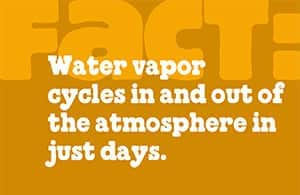 we increase the atmosphere’s ability to hold water vapor. Water vapor can then amplify the warming, especially in cold and dry regions. Increased presence of water vapor is causing the poles to melt even faster. International climate experts don’t talk much about H2O and climate change, because its role in global warming is a secondary complication caused by anthropogenic warming. We have to address the gigatons of other gases being spewed, and water vapor will take care of itself. So, there’s not much to do on the water vapor front.
we increase the atmosphere’s ability to hold water vapor. Water vapor can then amplify the warming, especially in cold and dry regions. Increased presence of water vapor is causing the poles to melt even faster. International climate experts don’t talk much about H2O and climate change, because its role in global warming is a secondary complication caused by anthropogenic warming. We have to address the gigatons of other gases being spewed, and water vapor will take care of itself. So, there’s not much to do on the water vapor front.
Recent Articles
Join The Climate Movement
-
With a landmark climate action agreement in place including commitments from 196 countries to fight climate change, now is the time to keep the pressure on and ensure swift action. This climate agreement wouldn’t have happened without millions of people around the world taking action. And we won’t be able to meet the ambitious goals of the Paris Agreement without millions and millions more people taking action in support of a rapid transition to clean energy. Paris was just the beginning, not the end. Let’s get to work towards a greener, cleaner future. Add your voice to the millions demanding action and sign the petition today!


